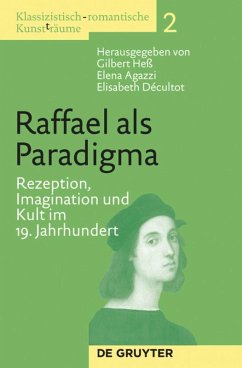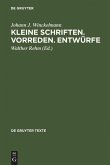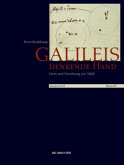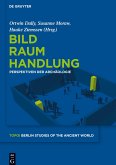This book, the second volume of the series Klassizistisch-romantische Kunst(t)räume, follows on directly from issues examined in the first volume. Both Graecomania and the Raphael cult can be viewed as concepts of salvation that are translated into the field of aesthetics and that reference each other complementarily. The adulation of Raphael was a notable feature of 19th-century art criticism and art history as well as of literature and music history. Raphael became a paradigm: he served as a screen onto which not only art-theoretical but also religious and social notions were projected, positing the ideal role and status of the artist and of people in general in his time
Als Maler, aber auch als künstlerischem Rollenmodell wurde Raffael im 19. Jahrhundert eine einzigartige Stellung zugesprochen. Vorbereitet durch eine lange, schon im 16. Jahrhundert einsetzende Rezeptionsgeschichte, stand die Verehrung seines Werkes wie seiner Person um die Wende zum 19. Jahrhundert auf einem Höhepunkt. Der Raffael-Kult erfasste Kunstkritik und Kunstgeschichte ebenso wie Literatur und Musikgeschichte. Raffael wurde zum Paradigma: Auf ihn wurden nicht nur kunsttheoretische, sondern auch religiöse und gesellschaftliche Vorstellungen projiziert, welche die ideale Stellung des Künstlers und Menschen in seiner Zeit benannten.
Die Raffael-Rezeption steht im 19. Jahrhundert unter einer Spannung, die sich aus dem Gegen- und Miteinander der Aktualität eines künstlerischen uvres aus dem 16. Jahrhundert und dessen Historisierung ergibt. Sie umfasst sowohl die Fortschreibung bzw. neue Entwürfe von Künstlerlegenden als auch die Entwicklung historisch-wissenschaftlicher Methoden zu Biographie und Kunstgeschichte.
Das auf den Vorträgen einer trilateralen Konferenz in der Villa Vigoni im Dezember 2007 basierende Buch bildet den zweiten Band der Reihe Klassizistisch-romantische Kunst(t)räume und schließt unmittelbar an Fragestellungen an, die im ersten Band untersucht wurden.
Als Maler, aber auch als künstlerischem Rollenmodell wurde Raffael im 19. Jahrhundert eine einzigartige Stellung zugesprochen. Vorbereitet durch eine lange, schon im 16. Jahrhundert einsetzende Rezeptionsgeschichte, stand die Verehrung seines Werkes wie seiner Person um die Wende zum 19. Jahrhundert auf einem Höhepunkt. Der Raffael-Kult erfasste Kunstkritik und Kunstgeschichte ebenso wie Literatur und Musikgeschichte. Raffael wurde zum Paradigma: Auf ihn wurden nicht nur kunsttheoretische, sondern auch religiöse und gesellschaftliche Vorstellungen projiziert, welche die ideale Stellung des Künstlers und Menschen in seiner Zeit benannten.
Die Raffael-Rezeption steht im 19. Jahrhundert unter einer Spannung, die sich aus dem Gegen- und Miteinander der Aktualität eines künstlerischen uvres aus dem 16. Jahrhundert und dessen Historisierung ergibt. Sie umfasst sowohl die Fortschreibung bzw. neue Entwürfe von Künstlerlegenden als auch die Entwicklung historisch-wissenschaftlicher Methoden zu Biographie und Kunstgeschichte.
Das auf den Vorträgen einer trilateralen Konferenz in der Villa Vigoni im Dezember 2007 basierende Buch bildet den zweiten Band der Reihe Klassizistisch-romantische Kunst(t)räume und schließt unmittelbar an Fragestellungen an, die im ersten Band untersucht wurden.









